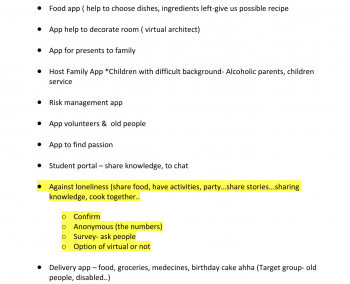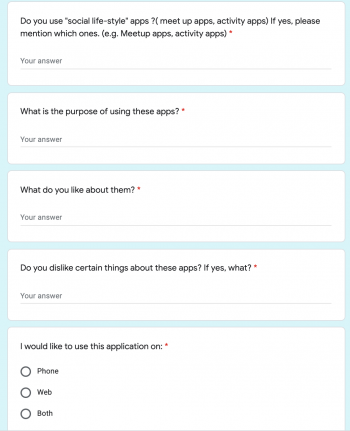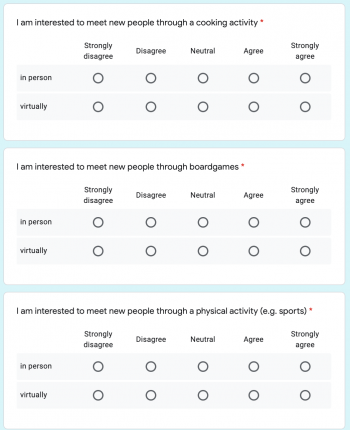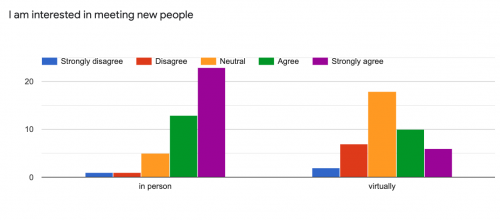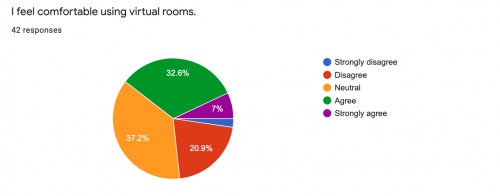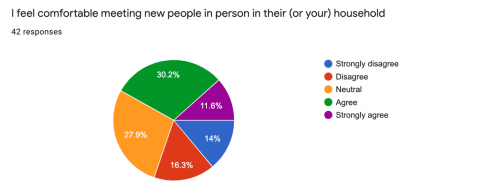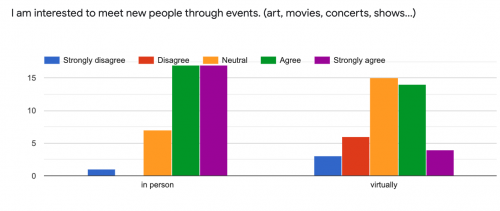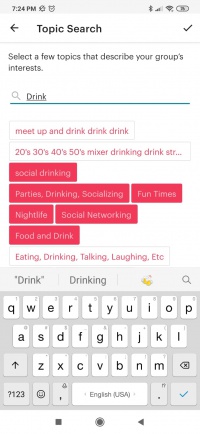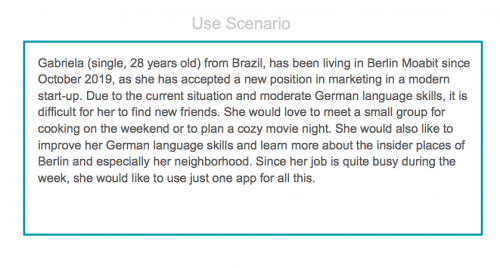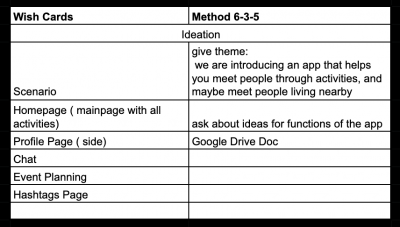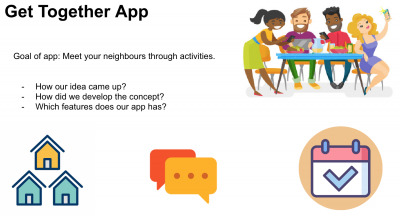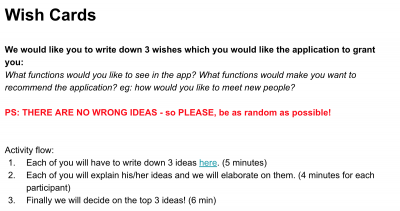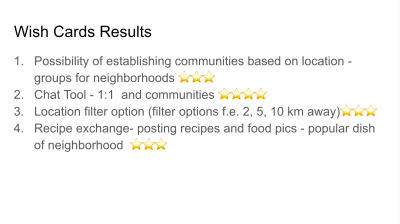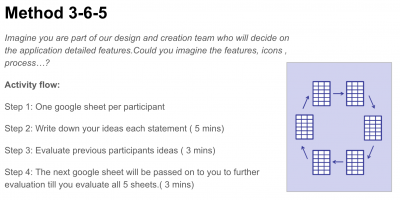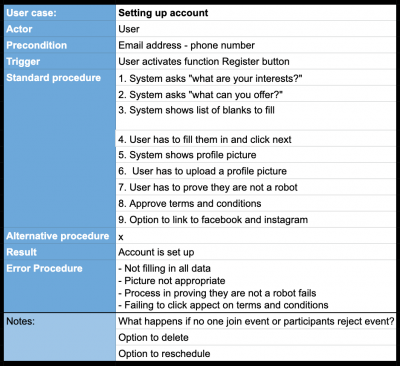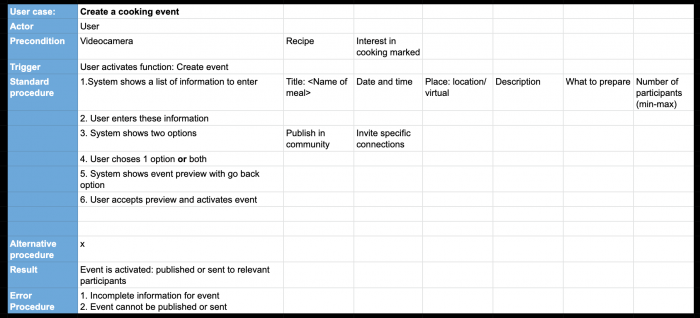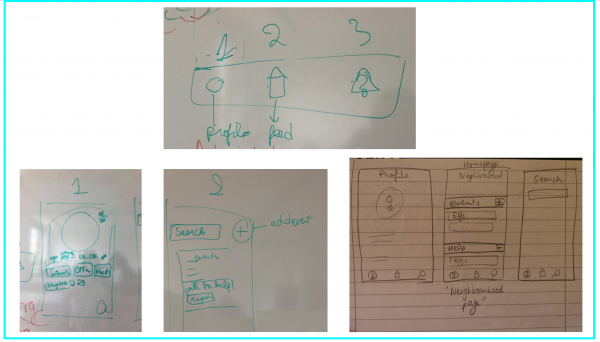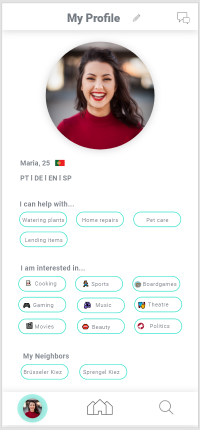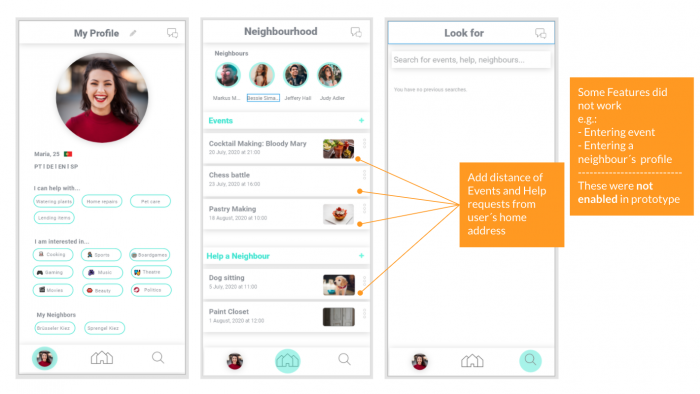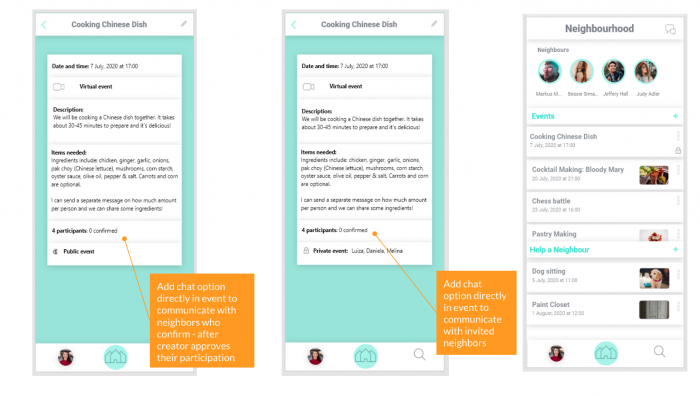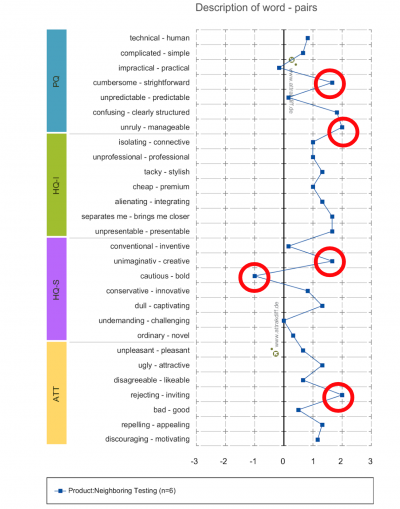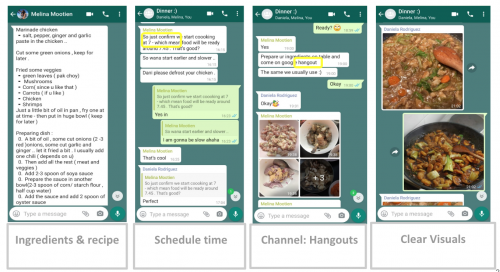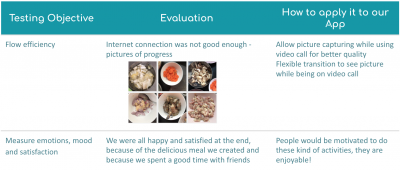Group 4 - Neighbouring App
Contents
- 1 Contextual Inquiry
- 2 User Target Groups
- 3 Focus Groups
- 4 Heureustic Evaluation
- 5 Use Cases
- 6 Prototype
- 7 Prototype Testing
- 8 Results and Conclusions
- 9 Documentation
- 10 References
Contextual Inquiry
Team Objectives
1.Team rules
- Be responsive
- Listen to each other
- Vote to agree (if there was too many opinions)
- Be empathetic
- No meeting when not needed
- Do not interrupt
- Be productive and efficient!
2. Team culture
- Celebrate every success
- Treat yourself
3. Team Member Roles
- Luiza = Creative brains
- Melina = Efficiency Moderator
- Julia = Perfectionist
- Laura = Time Manager and Mood Moderator
- Daniela = Operational brains
4. 1st Meeting
Goals and Objectives of Contextual Inquiry
The Contextual Inquiry is aimed at expanding our knowledge on each of: (1) the User, and (2) the Application.
1. The User
- Understand the user interests regarding the main topic of the application.
- Understand the profiles of users who would use the application.(i.e identify target group)
2. The Application
- Identify and decide on possible functions the app would provide.
- Identify details relevant to the features and layout needed for the application such as color, display, general style, and other aesthetic aspects.
Brainstorming Ideas for the App
During the first lessons of this discipline, we were asked to discuss what type of Application we would like to work on. In this sense, we needed to decide on the idea of the app. All the members of our group had a lot of suggestions, but one idea stood out for everyone - an app about bringing people together. The application would stimulate people to get to know each other by sharing activities and exchanging help.
Goals of the App
1. To offer and ask for help within the neighbourhood
2. To reduce loneliness by allowing neighbours to meet and connect over events
3. To create a sense of community within the neighbourhood
Description of the App
In a world where people tend to interact more with their phones than with other people, Neighbouring App aspires to build a sense of community, turning neighbours into people you can rely on. The app seeks to create relationships - by asking people to save a package for you, offering clothing items that you don’t use anymore, or just by getting together for a hike on a sunny morning.
Our app is about fighting urban loneliness with affection.
Main Functions of the App
The Main functions of the Application are:
1. Creating online and offline events:
Neighbours could get together in person or schedule a fun activity to do online by creating various events.
2. Offering and receiving help from neighbours:
Neighbours could create a "Help a Neighbour" request so people within the neighbourhood could recognise their needs and decide whether to help or not.
How would these functions work?
We realised that in order for the app to reach its goals, we would have to connect people in the neighbourhood who have similar interests and that can help each other in some way. For that reason, we got inspiration from the Meetup App, and decided to ask the users about their hobbies or interests and ways in which they might be able to help their neighbours. This information is to be collected after the user creates an account and signs into the app for the first time. In this sense, the app would automatically provide a few options related to interests and offers for neighbourly help.
- Interests: as a basis for events: gaming, board games, cooking, sports/fitness, music (definition of genres), movies, hiking, tech, beauty, shopping.
- Offers for help: as a basis for help requests: pet care, plant care, home repairs, save your package, companionship/friendship, second hand items.
Method: Survey
Goals and Objectives
- Understand the most desirable functions from the users´ perspectives
- Understand if users prefer to meet people in person or virtually
- Identify the most desirable activities which users would like to engage in
Planning
The team followed the following steps in creating the survey:
- Agreeing on Method (Online survey easier within the Covid/quarantine situation)
- Creating questionnaire
- Agreeing on the final questionnaires and on our target group
- Creating a consent note
- Agreeing on Google Forms as a tool to be used for online questionnaires
- Inserting questions and activating the survey
Survey Tool
The chosen survey tool was Google Forms since it is a free and simple tool which allows for co-editing effectively. This made creating the survey a quick and easy task since all team members could participate at the same time without having to be physically present in one location.
Recruitment and Participants
- We agreed to have a sample of participants which includes people who already use similar social applications and people who do not.
- Each team member forwarded the survey to at least 4 friends.
- Total sample was 42 Applicants
Results
The survey showed the following results:
- The majority of participants (63.6%) agreed to use this application on their phones.
- The majority of participants strongly agreed to meet new people in person.
Moreover, the majority of participants responded as neutral to meeting new people virtually.
- 37.2% participants responded as neutral about feeling comfort using virtual rooms.
Moreover, 32.6% participants responded as agreed about feeling comfort using virtual rooms.
- 32% participants agreed to meet new people in their household. 27.9% of participants responded as neutral.
- Most participants agreed and strongly agreed that they feel comfortable to engage in some activities to meet new people in person, and virtually.
Findings
The results helped to design observational interview guideline and identifying users for the interview.
Observational Interview
Goals and Objectives
- Understand the general purpose of the use of chosen social apps
- Understand the important function and features within the apps from the user perspective
- Understand the preferences and the disfavours of these apps
Planning
The planning of the observational interview included the following steps:
- Agreeing on the applications that our participants will be using
- Agreeing on the tasks that the participants will be asked to perform
- Preparing observational interview guideline which consists of:
- an oral consent step at the beginning of the activity
- an intro to the activity
- format of questions to be asked (open ended) and sample questions for every task
- questions to avoid in order to respect privacy of participant
- three main criteria to inquire about, namely: usage, features, and general Design
- space to document the collected information
Observational Interview Tools
Chosen apps:
The team decided that the following social apps are closest in concept to our application since they allow users to create events and meet new people.
- Bumble
- Meet up
- Jodel
Observational interview guideline
This guideline helped each team member to carry out the observational interview in a structured manner, while still leaving room for participants to express themselves freely.
The below picture shows the guideline:
- We agreed to find users who already use similar apps such as Jodel, Bumble and Meet up.
- Each team member tries to recruit one participant at least.
- 3 participants were observed online and 2 participants were observed physically.
- Preparation of logistics consisted of: scheduling time, arranging zoom meeting for online observations, and preparing observation guideline sheet.
- Total sample was 5 participants.
- A better understanding of users/ people like and dislikes.
- Identifying some restrictions in some applications, which could be an advantage in our future app.
- Identified that the design of the interface such as colour, simpler fonts for users is also important.
- Identified also that some users might feel comfortable to use the app possible activities due to similarity(since they all do not know anybody, hence all are open to get to know each other).
- Got advice on how icons can be simple to facilitate usability and recognition
- Also identified what feature might useful for app for large range of users such as anonymous (hence people can write their feelings and thoughts..)
- Explore desired functions within the app's general topic
- Elaborate on these functions
- Understand the user needs to achieve the functions successfully
- Understand what would work and what would not work for potential user
- Explore the user's expectations on the processes of functions
- We decided which methods we want to use for our focus group.
- We identified the functions we want receive feedback on during the focus group.
- We draft the flow of the focus group and allocate task to each team member.
- Step 1: Ice Breaker Activity
- Step 2: Introduction to our application
- Step 3: Wish cards activity
- Step 4: Method 3-6-5 activity
- Time management
- Short introduction of every participant, makes it more comfortable / familiar
- Flow and flow management ( having plan b, someone to share links,.etc)
- Giving an incentive
- Having diverse participants; e.g. different sex and nationalities
- Collecting detailed feedback from participants
- A minimum of 5 participants
- Having a well structured flow
- Commiting to a maximum of one hour duration
- Having more icebreakers
- Making sure that are participants already use similar apps or are matching with our personnas (target group)
- Providing more time for participants during activities
- Imroving the clarity (larger font) of documented questions
- Scheduling focus group sessions on weekends instead of weekdays(according to some participants feedback)
- Recipe exchange- posting recipes and food pics - popular dish of neighbourhood
- Greater Focus on neighbourhood
- Adding filter options
- Adding details on where, how long, what...etc for events
- Allowing online call for some activities
- Add background information and interests to the user´s profile
- Creating communities for neighbourhoods
- Adding a Chat Tool - 1:1 and communities
- Using icons for interests and offers
- Adding star review option: for example (beginner caretaker, professional hugger, best groomer), more features
- Inserting descriptions for `help option`
- Testing and evaluating the usability of the App MeetUp
- Comparing the usability of the App with the participants´ expectations
- Identifying potential problems in the MeetUp App
- Testing usability heuristics based on chosen criteria
- Introduction of Meetup app:
- c
- Evaluation criteria:
- Creating requirements as a sequence of possible interactions between system and user
- Providing an abstract description of functions and their requirements
- Creating a clear structure for prototype creation
- Adobe XD is a prototyping tool for web and mobile apps, by Adobe Inc.
- Allows to create modern designs (which is preferred for the creation of a social app)
- Allows to create endless connections and prototype
- Seems not too difficult to learn
- Has Windows and MacOs versions (flexible to download for all teammates)
- Current free version includes:
- Name: The original name was `Get together app` but after the neighbouring element became salient in the app, we agreed to change the name into a self-explaining and straightforward title, namely ´Neighbouring´.
- Logo: The Logo created was aimed to be simple and straightforward. We drew samples by hand and then created some online.
- Understand how intuitive is the user interface
- Understand what functions work
- Evaluate performance for multiple tasks
- Receive feedback on the design and aesthetics of the prototype
- Identify errors and areas of improvement
- Agreeing on methods to use during user testing
- Selecting criteria to be evaluate
- Preparing a presentation to introduce application and the process to participants
- We agreed to recruit two types of participants: Some who never participated previously with us, and others who were involved in the Contextual Inquiry and Focus Groups.
- The Testing was carried out virtually via Zoom since it was more practical for users, and it was easier to observe and record their interaction with the prototype.
- Emotions and behaviors
- Performance (speed, achieveing performance or not)
- General interface evaluation
- Hedonic Quality
- Pragmatic Quality
- Attractiveness
- Task Completion
- Time for Task
- Flow Efficiency
- Emotions, mood, and satisfaction
- Positive feedback, emotions, and performance include:
- Improvement suggestions include:
- Positive feedback, emotions, and performance include:
- Improvement suggestions include:
- Positive feedback, emotions, and performance include:
- Improvement suggestions include:
- Measure the attractiveness and aesthetics of the interactive prototype.
- Enables users to can give a subjective evaluation of the operation and appearance of the interactive prototype
- http://www.attrakdiff.de/
- We chose Attrakdiff short: Individual evaluation from 4 possible questionnaires options.
- The questionnaire has 30 randomised items.
- The questionnaire has a good usability; it is simple, short, and easy.
- It measures how likely is the prototype to be characterised by one adjective compared to its antonym(Word-pairs).
- Hedonic Quality: Stimulation & Identity
- Pragmatic Quality
- Attractiveness
- Most participants agreed the application is rather straightforward, manageable, creative, and inviting. However, they thought it is more cautious than bold.
- The average mean score of each evaluation criteria is higher than 0 which shows means the results is good.
- The confidence rectangle indicates the users´ preference and evaluation of the prototype.
- All 5 participants acted intuitively
- The Prototype is presentable
- Major concern: privacy (especially address and GPS location)
- Still lots of potential for improvement
- Public profiles include name only; no family name.
- Clear explanation of what data will be shown to who (address).
- Previously mentioned improvements (icons, info pop-ups..).
- Specific entries for creating different events.
- Update of data protection and clarification
- Development of profile creation step
- Creation of different events/help requests and test them
- Evolution of Chat channels
- Development of the Business Model (Freemium)
- Adobe XD learning
- Task allocation
- Team working skills ( especially in a virtual setting)
- Team roles (Extension of Strengths)
- Prioritisation
- Different methods & tool usage (focus groups, use cases..etc)
- New ideas & Features from participants
- Agile Approaches: Work in increments
- How to focus on User opinions in most steps
Recruitment and Participants
Observation
Here are some of the screenshots taken during the observation:
Task A: Create an event on Meetup:
Task B: Search for an event on Meetup:
Results & Insights
User Target Groups
Personas
Based on data collection
Scenarios
Focus Groups
Goals and Objectives
Planning
Recruitment and Participants
As participants for our Focus group we contacted different persons with the goal to recruit at least 5 participants. The idea was to make it as much comfortable and clear as possible for the attendants and the observers. We also tried to recruit two more person as backup. As final constellation the participants were mixed group of men and females from Mauritius, Germany, Lebanon and Cambodia in the ages from 25 to 30 years old.
Procedure & Activities
We guided the participants through the process of the focus group through a PPT as follows:
Findings
General Learnings
To Keep
To Improve
Takeaways for Application
To Keep
Suggestions
Heureustic Evaluation
Goals and Objectives
Planning
We created a Google Slides document to have a quick overview of what the MeetUp App is about. This includes its purposes and other details such as price and functions. Below is a screenshot of the slide:
For the evaluation we needed to choose some evaluation criteria. In our case we though the following were important to test the MeetUp App for further use in our research for the development of our App:
This criteria was evaluated in a protocol sheet which included the following categories of priority: cosmetic (very low), minor (low), major (high) and disaster (urgent). Also the experts needed to clarify why they chose one of these options and suggest how the problem could be solved.
Recruitment and Participants
This acitvity was carried out with another group from our user experience course. The group consisted of 5 members.
Results and Insights
Problems in the chosen app and their relavant solutions were identified based on the heuristic criteria(violations of a heuristic).
Based on the table above, we could conclude that the heuristic suitability for task had a really big problem: "safety". Participants were concerned that there might be fake profiles. This would be something we would try to avoid in our App. As suggested, an ID verification could be implemented in this case. A major concern was the fee policy, so for our App, we will be clear from the beginning. Our business model will be Freemium (1st month free and then they would need to pay a monthly fee). The price would not change, even if our App becomes very famous.
Use Cases
Goals and Objectives
The Three Use Cases
Use Case 1: Setting up account
Use Case 2: Surfing the App
Use Case 3: Create a cooking event
Prototype
Prototype Planning
Tool
Adobe XD
Reasons for choice:
(1) Unlimited designing and prototyping
(2) Unlimited editors, shared documents, and shared links until October 2020.
(3) Adobe Fonts free (limited set of fonts)
(4) 2GB of cloud storage
Prototype content
Based on the use cases, the general access that the prototype should provide was brainstormed and collected.
An example of that is the following:
Design and Creation
The creation of the application can be divided into two main parts: The creation of the App name and logo on one hand, and the creation of the Interface of the application on the other.
Name and Logo
Prototype Sketches
Final Product: Prototype
Signing up
Profile
Neighbourhood
Search
Create event
Prototype Testing
Goals and Objective
Planning
Recruitment and Participants
Operationalization
Method 1: Observational tasks
Measures:
Method 2: Usability Questionnaire
Measures:
Method 3: Simulation
Measures:
Observational Tasks
Sign up and confirm address
Surf the App
Creating an Event
Usability Questionnaire
Goals and Objectives
Instrument
Analysis
Main evaluation criteria
Results
But the sample was not big enough to rely on quantitative analysis. These results mainly help us to identify the most attractive and desirable characteristics associated with our application.
A small confidence rectangle in the section of Self oriented & desirable means that the investigation results are more reliable and less coincidental.
Simulation
We wanted to simulate a virtual cooking event, to test if it actually works and could be something feasable for people to do. In this way we could gather information through self-experimentation, one of the best ways to prove it.
Planning
To plan it, we realised that there are some things important when planning a cooking event:
The ingredients and recipe was very important to have it forehand, to buy the thing that we were missing.
Realization
After we plan the event we just needed to start cooking :) Each of us was on their own place and with their own utensils. So we began with the videocall, where Melina was guiding us through the process. We had a lot of fun and we were spending also quality time with our friends even if it was virtually. It was a whole new experience, which we really appreciate it!
Results
At the end we had 3 delicious typical Mauritian dishes:
Based on our experience we did an analysis and we came up with the following results:
Task Completion: all of us was able to achieve the task (cook the mauritian dish, through virtual guidance).
Time for task: it is important to consider that it might take longer as usual to cook the dish, because you are chatting and trying to guide others to cook a dish they have not done before.
Flow efficiency: sometimes internet was not good enough to have a good quality videocall, so we needed to send extra pictures from our process to verify if the cooking was going well (e.g. how to cut ingredients properly, texture of dish, etc..). We would like to have a function where the user can make screenshots while having the videocall, and these pictures will go automatically to the common chat.
Emotions, mood and satisfaction: we really enjoyed the moment and were really happy and satisifed with the results!
Results and Conclusions
General Results
Room for Improvement
Safety and Data Protection:
App Functionality:
Future Realisation Steps
General Learnings
Difficulties
Takebacks
Documentation
1. Ideas
3. Survey
6. Focus group
7. Prototype
9. Use cases
10. User testing
11. Simulation

